Discover why the bloodhound is the ultimate tracker, renowned for hunting and search-and-rescue roles. Learn about their history, purpose, physical and behavioral traits, care tips, training tips, bonding and why they make great hunting and family dogs.
Extraordinary Breed
Imagine a world where tracking scents across vast distances was an art form, perfected by one extraordinary breed. Enter the bloodhound, a dog with an unparalleled sense of smell and a storied history that dates back centuries. Their keen noses and relentless determination have earned them a legendary status among hunters and trackers alike.
Whether you’re a hunter, a dog enthusiast, or someone considering a bloodhound as a new companion, in this article you’ll discover their rich history and the reasons behind their exceptional tracking abilities. We’ll cover everything from their origins to their roles in hunting, search and rescue, and law enforcement, providing insights into why they excel in these fields. Join us as we uncover the secrets of this amazing breed.
The Origin and History of Bloodhounds
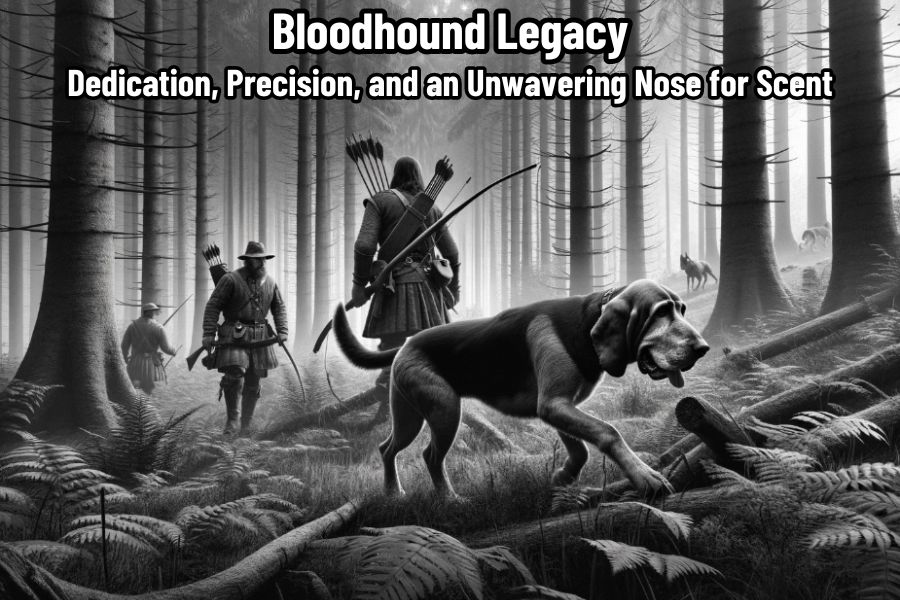
Ancestors
Imagine a time when medieval hunters roamed the dense forests of Europe, relying on their trusted dogs to track elusive prey. The bloodhound’s ancestors were among these esteemed canines, prized for their extraordinary scenting abilities. These early hounds were meticulously bred by monks and noblemen, who recognized their unparalleled talent for following trails. Known as St. Hubert hounds in honor of the patron saint of hunters, these dogs laid the foundation for the modern bloodhound. Their legacy is one of dedication, precision, and an unwavering nose for scent.
Evolution
As centuries passed, the bloodhound evolved, adapting to the changing needs of hunters and society. The breed’s development was marked by a meticulous selection process, focusing on enhancing their already impressive tracking skills. They were crossbred with other hounds to refine their abilities, leading to the creation of a dog with not only exceptional scenting prowess but also the stamina and strength to cover vast terrains. By the Renaissance, these hounds had become synonymous with reliable trackers, their reputation spreading far beyond Europe’s borders. In 1885 the breed was recognized by the American Kennel Club (AKC).
Modern Breed Today
Today, the bloodhound stands as a testament to centuries of careful breeding and training. These remarkable dogs are celebrated not only for their hunting capabilities but also for their roles in search and rescue and law enforcement. These modern hounds are utilized worldwide to locate missing persons, track fugitives, and even aid in disaster response. Their keen sense of smell, capable of detecting scents up to 300 hours old, remains unmatched. The breed of today is a blend of history and innovation, a living legend that continues to capture the hearts and respect of those who work alongside them.
Bloodhound In Action
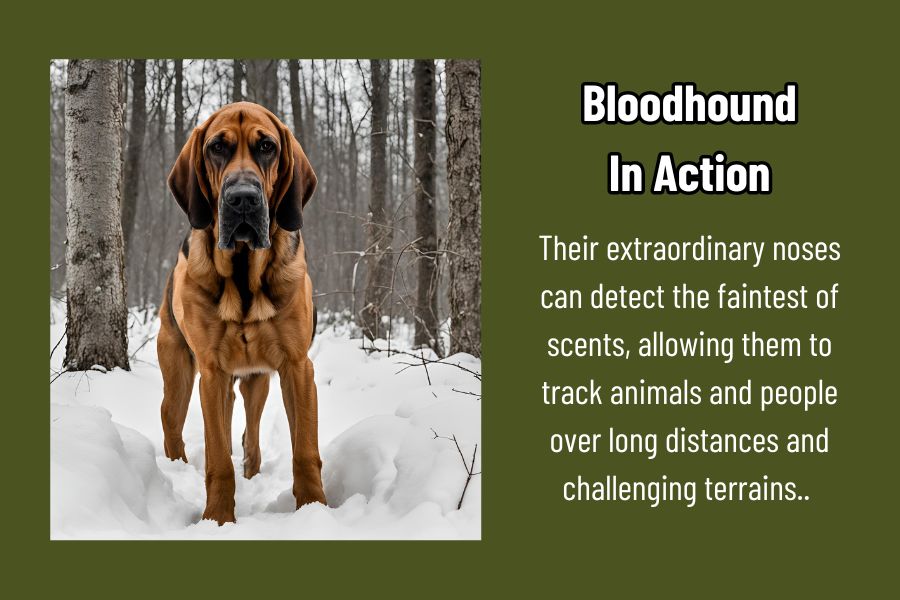
Bred as a Scenthound for Hunting Big Game and Small Game
The bloodhound was originally bred with a singular purpose: to be the ultimate scenthound for tracking both big game and small game. Primarily bred to hunt deer, wild boar, and rabbits makes them very valuable to hunters even today. Their extraordinary noses can detect the faintest of scents, allowing them to track animals over long distances and challenging terrains. This unique ability to follow a trail even days old establishes them as legendary hunting companions.
Other Role: Search and Rescue
Imagine a missing hiker lost in the wilderness; a bloodhound’s powerful nose can pick up their trail and lead rescuers to them, sometimes from miles away. These scenthounds are trained to follow human scents over rugged landscapes, through forests, and across rivers. Their contributions have saved countless lives, providing families with hope and reunions in their darkest hours. Their dedication and precision in search and rescue operations are nothing short of heroic, a noble purpose for certain.
Other Role: Law Enforcement Tracking
In the realm of law enforcement, the bloodhound’s tracking prowess is legendary. These dogs are frequently employed to track fugitives, locate missing persons, and gather crucial evidence in criminal investigations. One notable case involved a hound named Nick Carter, who in the early 20th century, successfully tracked and apprehended numerous criminals, earning a place in history. Modern bloodhounds continue this legacy, assisting police and investigators with their unrivaled ability to follow a scent trail through urban environments, across state lines, and even in adverse weather conditions. Their contributions to justice and public safety are invaluable.
Bloodhound Physical Traits
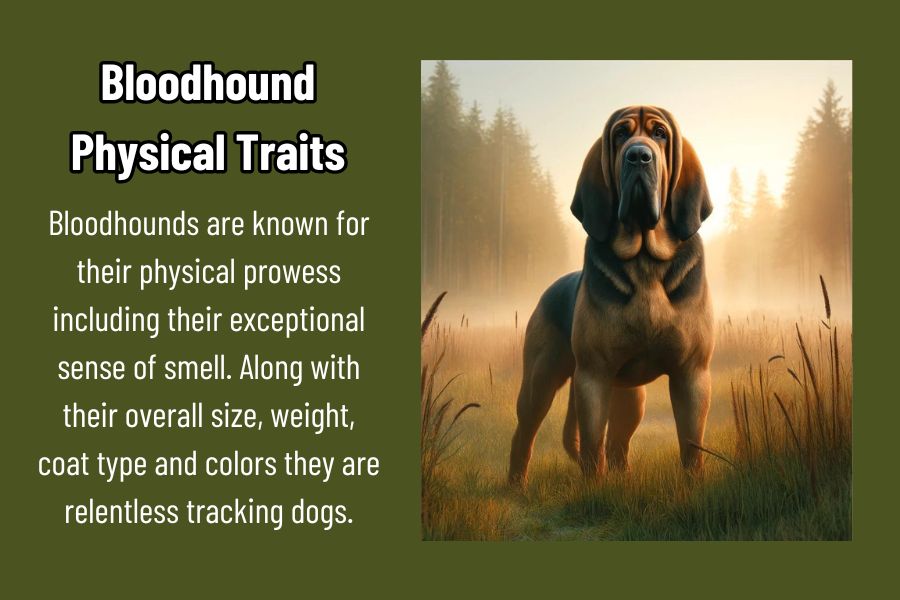
The bloodhound is a breed that stands out not just for its impressive tracking abilities but also for its distinctive physical traits. Let’s dive into what makes this breed physically unique and perfectly suited for its roles in hunting and tracking.
Size (Length and Height)
Bloodhounds are large and powerfully built dogs. Males typically stand between 25 to 27 inches at the shoulder, while females range from 23 to 25 inches. When it comes to length, these dogs can reach up to 48 inches from the nose to the tip of the tail. This considerable size gives them the strength and endurance needed to track game over long distances and through challenging terrains.
Weight
A healthy adult bloodhound usually weighs between 80 to 110 pounds, with males on the higher end of the scale. This weight is supported by a strong, muscular frame that provides both power and stamina. Despite their size, these hounds are agile and capable of moving quickly and efficiently while on the trail.
Coat Type and Colors
The bloodhound’s coat is short, dense, and weatherproof, providing ample protection against the elements. Through the 17th century these hounds were of many colors. Todays modern hounds typically come in colors such as black and tan, liver and tan, or red. These earthy tones not only help these hounds blend into natural surroundings but also add to their majestic and noble appearance.
Keen Senses
Perhaps the most remarkable physical trait of the bloodhound is its keen sense of smell. With approximately 300 million scent receptors, bloodhounds can pick up and follow a scent trail that is days old. Their long, drooping ears and loose, wrinkled skin around the face and neck help to channel scents directly to their nose, enhancing their tracking abilities. Their eyes, often a deep hazel or brown, are set low and far apart, giving them a soulful yet focused expression that reflects their dedication to the task at hand.
Life Expectancy
Bloodhounds typically have a life expectancy of 10 to 12 years. With proper care, diet, and regular veterinary check-ups, they can lead healthy and active lives well into their senior years. Maintaining their physical health is crucial, as their large size can make them prone to certain conditions such as hip dysplasia and bloat. Regular exercise and a balanced diet are essential to keep these noble hounds in peak condition.
Bloodhound Behavioral Traits
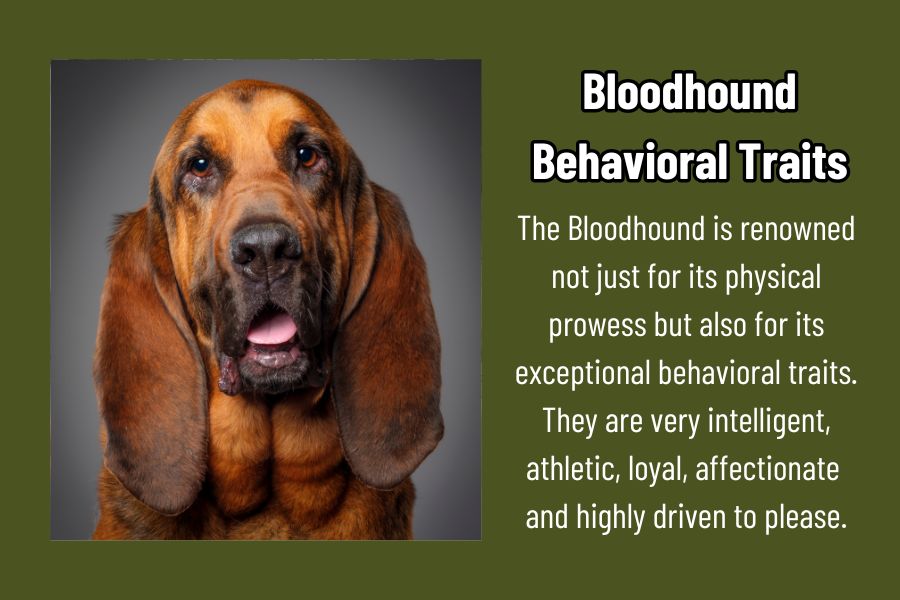
Prey Drive
The bloodhound is renowned for its intense prey drive. This natural instinct is deeply embedded in their DNA, a trait that has been honed over centuries of breeding for tracking and hunting. When this hound breed catches a scent, they become laser-focused, driven by an almost irresistible urge to follow the trail. This makes them exceptional hunting companions, as they will relentlessly pursue their target, whether it’s a deer, wild boar, rabbit or other game.
Mental Toughness
Bloodhounds are competitive but stay highly focused on the task at hand, the scent trail. They are, resilient and perform extremely well under pressure. Their mental toughness is not only driven by physical strength; it’s about their stamina and relentless drive to track scents for hours on end. These hounds will navigate through dense forests, climb steep terrains, and cross rivers with ease. Along with their natural instincts, their mental toughness is one of their most valuable traits.
Versatility
One of the most remarkable traits of a bloodhound is its versatility. While they are primarily known for their hunting skills, they also excel in other roles such as search and rescue and law enforcement. Their keen sense of smell and determination make them invaluable in locating missing persons or tracking down fugitives. This adaptability showcases their intelligence and ability to perform a variety of tasks beyond hunting.
Temperament
Bloodhounds are known for their gentle and affectionate nature. Despite their size and strength, they are incredibly patient and kind, especially with children. They have a calm demeanor that makes them well-suited for family life. Their friendly disposition extends to other dogs and pets, making them a harmonious addition to a multi-pet household.
Trainability
While bloodhounds are very intelligent, their independent nature can sometimes make training a challenge. They require a patient and consistent approach, with positive reinforcement being the most effective method. Their strong-willed personality means that early training and socialization are crucial. Once properly trained, they will follow commands reliably, making them very effective working dogs for hunting game or tracking people.
Loyalty
Loyalty is a hallmark of the bloodhound. These dogs form deep bonds with their owners, displaying unwavering devotion and affection. They thrive on companionship. This loyalty makes them excellent working dogs who will stick by your side until the job is done.
Why Bloodhounds Make Great Hunting Dogs?
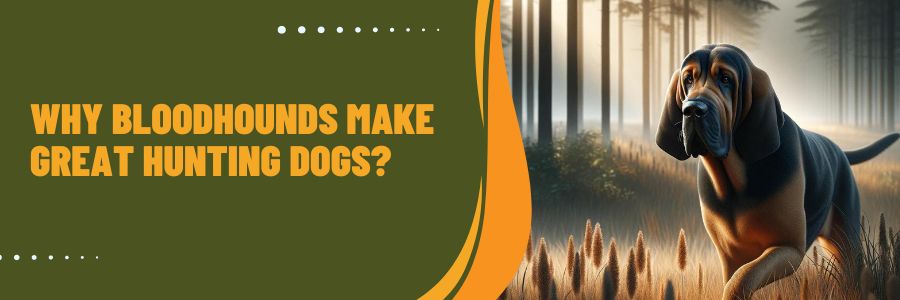
Few hunting dogs can match the bloodhound for dedication, skill, and tenacity. Their extraordinary sense of smell, with around 300 million scent receptors, allows them to detect and follow scent trails days old across challenging terrains. This incredible capability makes them exceptional at tracking big game like deer and wild boar and small game like rabbits.
Bloodhounds are also known for their relentless determination. Once they catch a scent, they are nearly unstoppable, driven by an instinct to follow the trail to its end. This unwavering focus is crucial for hunters who need a reliable partner that won’t be easily distracted and can maintain a consistent pace over long distances.
In addition to their scenting ability, bloodhounds have physical endurance and a friendly disposition. Their strong, muscular bodies can handle hours of tracking without tiring. Their loyalty and eagerness to please along with their scent skills and relentless determination make them a treasured member on any hunt.
Choosing the Right Bloodhound

Selecting the right bloodhound for your needs is a significant decision that requires careful consideration. These majestic dogs, renowned for their tracking abilities and loyalty, can be a perfect addition to your family or hunting team. Here are some tips to help you make an informed choice.
Understanding Your Needs
Do your own research. Before you decide on a bloodhound, it’s essential to understand why you want one. Are you looking for a skilled hunting companion, a reliable search and rescue dog, or a loyal family pet? Bloodhounds excel in various roles, but knowing your primary purpose will guide you in selecting a pup with the right traits and temperament.
Evaluating Breeders
Choosing a reputable breeder is crucial. A responsible breeder will ensure that their bloodhounds are healthy, well-socialized, and bred for both temperament and ability. Ask breeders about the history of their dogs, specifically inquiring about hunting bloodlines including awards or titles and any common health issues like hip dysplasia and bloat. Visiting the breeder’s facility can give you insights into how the puppies are raised and their living conditions. Look for breeders who have puppies with strong bloodlines, prioritize health, ethical breeding practices, and early socialization.
Assessing Physical Traits
When selecting a bloodhound, pay close attention to their physical traits. A healthy bloodhound pup should have clear eyes, a shiny coat, and an active demeanor. Check their ears, as bloodhounds are prone to ear infections due to their long, drooping ears. Ensure they have a sturdy, well-proportioned build, indicative of their strength and endurance.
Temperament and Behavior
Bloodhounds are known for their gentle and friendly nature. When choosing a pup, observe their behavior and interaction with their littermates and humans. A good bloodhound should be curious, confident, and show signs of being eager to please. Avoid pups that appear overly timid or aggressive, as these traits can be challenging to manage.
Health Considerations
Ask the breeder for health clearances and veterinary records. Bloodhounds can be prone to certain genetic conditions, so it’s vital to choose a puppy from a line with minimal health issues. Inquire about the parents’ health and any genetic testing that has been done. Early health screening can save you from potential heartache and unexpected expenses down the line.
Compatibility with Lifestyle
Finally, consider how a bloodhound will fit into your lifestyle. These dogs require regular exercise, mental stimulation, and social interaction. If you’re a hunter, an active individual or family, a bloodhound can be a great match. However, if you have limited time or space, you might need to consider a different breed. Bloodhounds thrive in environments where they can use their tracking skills and have plenty of mental and physical stimulation.
Caring for Your Bloodhound

Nutritional Tips
Feeding a bloodhound requires attention to their unique dietary needs to keep them in peak condition. These athletic dogs need a balanced diet rich in protein to support their muscle mass and energy levels. Look for high-quality dog food that lists meat as the first ingredient. Incorporating omega-3 fatty acids can help maintain a healthy coat and support joint health. It’s essential to feed them appropriate portions based on their weight and activity level to prevent obesity. Treats should be given sparingly and ideally should be healthy options that contribute to their overall diet.
Healthcare Tips
Regular health check-ups are vital for managing common breed-specific issues that bloodhounds may face. Bloodhounds are prone to hip dysplasia, ear infections, and bloat. Regular visits to the vet can help catch these issues early. Hip dysplasia screenings and routine blood tests can monitor their overall health. Due to their long ears, keeping them clean and dry is crucial to prevent infections. Be proactive with dental care as well, as dental issues can lead to other health problems. Vaccinations, parasite control, and a healthy diet are all part of maintaining your hound’s health.
Grooming Tips
Despite their short coats, bloodhounds require regular grooming to stay clean and healthy. Their coats should be brushed weekly to remove dirt, loose hair, and prevent matting. Bathing should be done as needed, especially after a muddy adventure or a long tracking session. Because they are active dogs, check their skin for cuts, rashes and ticks. Pay particular attention to their ears, which should be checked and cleaned weekly to prevent infections. Trim their nails regularly and brush their teeth to maintain dental hygiene. Keeping up with grooming not only ensures they look their best but also helps in early detection of potential health issues.
Exercise Requirements
Bloodhounds are high-energy dogs that need regular exercise to stay fit and healthy. Daily walks and play sessions are essential to keep them in shape for hunting and tracking activities. Without adequate exercise, bloodhounds can become obese, which leads to other health problems like joint issues and heart disease. Regular physical activity also helps prevent destructive behaviors and anxiety by keeping them mentally stimulated. Engaging in regular activities like hunting, scent work or agility training can provide both physical exercise and mental challenges, ensuring your hound remains happy and healthy.
Bloodhound Training and Obedience Tips
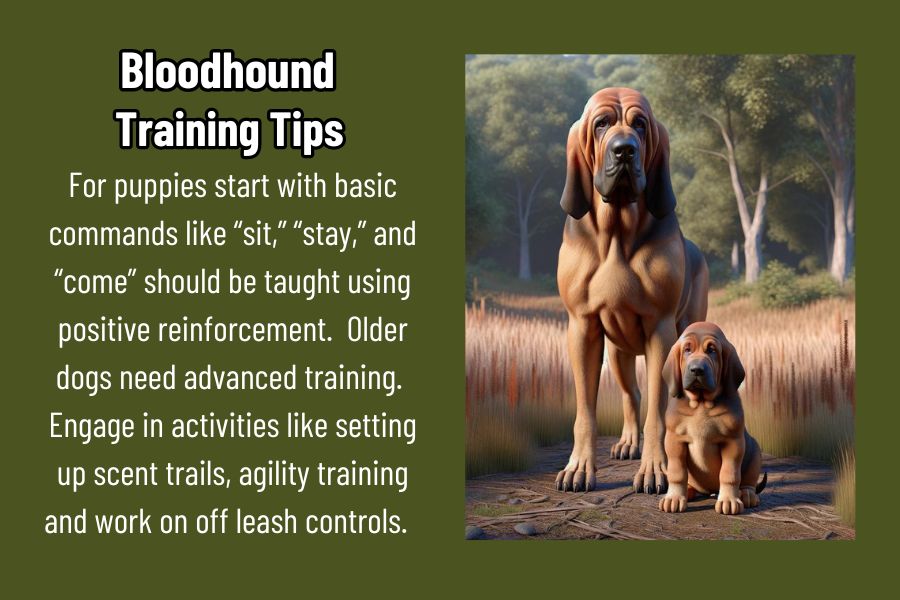
Puppy (Basic) Training Tips
Training a bloodhound puppy can be an exciting yet challenging experience. These intelligent and independent dogs require a consistent and patient approach. Start training early, as bloodhound puppies are highly receptive during their formative weeks. Socialization is crucial—introduce them to various environments, people, and other animals to build their confidence and adaptability. Basic commands like “sit,” “stay,” and “come” should be taught using positive reinforcement techniques. Healthy treats and praise work wonders. Keep training sessions short and engaging to hold their attention, and always end on a positive note to keep them eager for the next session.
Advanced Training Tips
Once your bloodhound has mastered basic commands, it’s time to move on to more advanced training. Given their exceptional scenting abilities, incorporating scent work into their training can be both stimulating and rewarding. Set up scent trails for them to follow, gradually increasing the complexity to hone their tracking skills. Advanced obedience training should focus on off-leash commands and impulse control, especially since bloodhounds can get easily distracted by interesting scents. Consistency is key—reinforce good behavior continuously and be patient with their learning curve. Engaging in activities like agility training or search and rescue exercises can also enhance their physical and mental sharpness.
Living with a Bloodhound
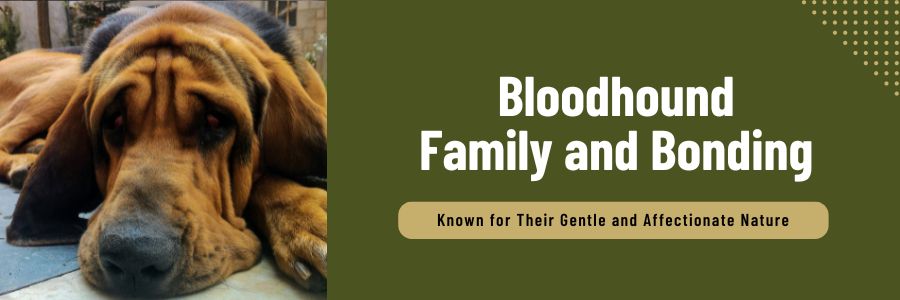
Family Environment
Living with a bloodhound can be a rewarding experience filled with adventure and companionship. These dogs are known for their gentle and affectionate nature, making them great additions to family life. These dogs are incredibly patient and can be wonderful with children, often displaying a protective instinct towards the youngest members of the household. However, due to their size and strength, supervision is necessary to ensure playtime remains safe and enjoyable for everyone. Bloodhounds thrive in an environment where they can be an active part of the family.
Bonding
The bond between a bloodhound and its owner is something truly special. These dogs are known for their loyalty and deep attachment to their families. Building a strong bond with your hound involves spending quality time together, engaging in activities that both you and your dog enjoy. Regular training sessions, playtime, and even simple cuddles on the couch can strengthen your relationship.
Bloodhounds are sensitive dogs and respond best to positive reinforcement. Harsh response methods can damage their trust, so always use gentle and consistent techniques. This breed is also highly intuitive and can sense your moods, often offering comfort when you need it most.
Conclusion
In conclusion, we’ve covered why the bloodhound is a remarkable breed known for its exceptional tracking abilities, rich history, and gentle disposition. We’ve also explored their their impressive roles in hunting, search and rescue, and law enforcement, and their physical and behavioral traits that make them unique. In addition, we’ve also delved into essential care tips, training strategies, and the joys of living with a bloodhound. As you consider adding this hound breed to your life, remember their incredible capabilities and the deep bond they form with their families. Embrace the adventure and companionship that come with this extraordinary breed, and you’ll find a loyal and devoted partner in every sense.
FAQs: Bloodhounds
- How far back can a bloodhound trace a scent? They have an extraordinary ability to follow scent trails that are up to 300 hours (approximately 12 days) old. This incredible skill makes them invaluable in search and rescue operations and criminal investigations.
- How many scent receptors do bloodhounds have compared to humans? They have around 300 million scent receptors in their noses, while humans have only about 5 million. This significant difference explains their unparalleled tracking abilities.
- Why do bloodhounds have such long ears and droopy skin? The long ears and loose, wrinkled skin serve a practical purpose. The ears help to sweep scent particles towards their nose, and the folds of skin trap the scent, enhancing their ability to follow a trail.
- Can a bloodhound’s tracking results be used in court? Yes, their tracking results can be used as evidence in court. Due to their reliable tracking abilities, bloodhounds have helped solve numerous cases by providing critical evidence that leads to convictions.
- What is the longest distance a bloodhound has successfully tracked? One of the most famous tracking records is a distance of over 130 miles. This feat showcases the breed’s endurance and determination, as they can track a scent over vast distances without giving up.
- How did bloodhounds get their name? The name “bloodhound” comes from their status as a “blooded hound,” meaning they were of noble and pure blood. They were originally bred by noblemen and monks to be exceptional scent trackers, and the name reflects their distinguished lineage.
Resources: Bloodhounds
SPECIAL NOTE: “The information provided in this post is based on Google research and the Resource links listed below. While we try to keep the information for this post current, there are no representations expressed or implied, about the completeness, or accuracy of the information provided. Therefore all hunters should always verify current information from these resources along with other local and federal publications”.
Online Resources
- AKC – American Kennel Club
- TKC – The Kennel Club
- UKC – United Kennel Club
- CKC – Canadian Kennel Club
Best Books
- “The Complete Bloodhound” by Catherine F. Brey This comprehensive guide covers everything from the history and characteristics of bloodhounds to training, care, and health. It’s a valuable resource for both new and experienced owners.
- “Bloodhounds: A Complete Pet Owner’s Manual” by D. Caroline Coile Ph.D. This book provides detailed information on bloodhound behavior, training, health care, and their roles in hunting and search and rescue. It’s an accessible and informative read for anyone interested in the breed.
- “Bloodhound Training Guide: The Essential Guide to Training Your Bloodhound Puppy” by Daniel Joseph Focused on training, this book offers practical advice and techniques for training bloodhound puppies. It covers basic obedience, advanced training, and tips for handling common behavioral issues.
- “The Bloodhound Handbook” by Douglas L. Oliver An in-depth look at the bloodhound breed, this handbook covers the history, development, and modern roles of bloodhounds. It also includes sections on health, nutrition, and grooming.
- “Bloodhounds: History, Breeding, Training, and Management” by Edwin Brough and G.S. Lowe This classic book, written by two experts in the breed, delves into the historical development, breeding practices, and management of bloodhounds. It’s a must-read for enthusiasts and breeders.

